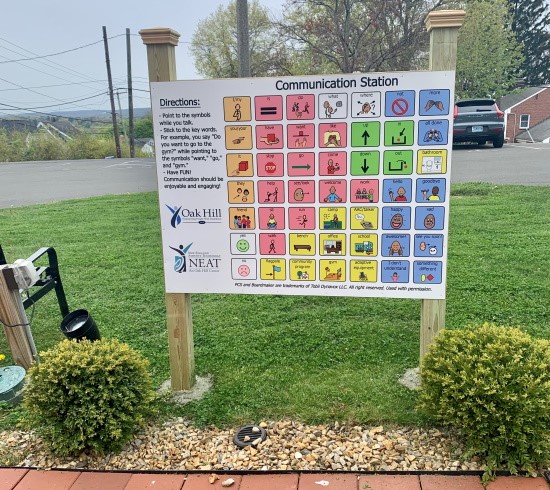AAC for Playgrounds and Beyond

This summer, TechOWL (the PA AT Act Program) and Oak Hill’s NEAT Center (a partner of the CT Tech Act Project) are building community with communication boards for outdoor recreation, learning, and public awareness. #DisabilityPride
NEAT Center’s Communication Station installed at 120 Holcomb Street in Hartford.
In 2019, a Michigan non-profit, Communication is Key, posted a message to Facebook about a large all-weather alternative and augmentative communication (AAC) board they’d installed at a playground to support children with complex communication needs. On August 27, the post went viral (amassing nearly a half-million views). “People from all over the world have reached out, including the U.K., Australia, South Africa, South America, Canada, and many different cities across the United States! How exciting to be able to reach our community like that and spread awareness for our kiddos!” reported Executive Director Julia Dapkus.
Since then (and before), symbol-based boards have been installed in multiple states to support visitors who communicate using AAC. In 2021, news outlets reported playground AAC signage in Michigan, Minnesota, Maryland, New Jersey, and Massachusetts (where the Doug Flutie Foundation is providing grants for boards throughout the Commonwealth).
On playgrounds, communities around the country are helping to grow a culture of inclusivity. Communication boards display symbols and words for selection by users with speech disabilities (and others) to convey needs, feelings, wants, and ideas. These outdoor symbol-based boards support equity, raise awareness, and make it easier for people of all abilities to interact with one another.
Children who use AAC face a unique challenge. When playing outside with their classmates, taking an AAC device with them means the device can get broken or lost. But without it, there is no way for the child to communicate with their friends or teachers.
Playground Core Communication Boards | AAC Language Lab of PRC-Saltillo
Last fall, TechOWL (the PA AT Act Program) took the AAC-for-playgrounds concept to the city of Philadelphia. The program is now partnering with Philadelphia Parks and Recreation, disability organizations, and self-advocates to improve access to communication at playgrounds and other recreational spaces. With input from recreation site staff and self-advocates in the disability community, TechOWL created a free downloadable communication board using symbols from the Noun Project (which has icons beyond nouns that are not associated with a specific company, device, or AAC app). The board is available to print for community use at playgrounds or another place of recreation.
TechOWL and Philadelphia Parks and Recreation are also working to ensure large communication boards are installed as new playgrounds are built, and TechOWL speech therapists recently held a training for park staff on tips for interacting with non-speaking visitors using laminated communication boards. (500 will be disseminated around the city this summer.) TechOWL plans to add more free downloadable boards for use with different activities and in multiple languages.
Everyone has the right to communicate. Communication boards at playgrounds and recreation centers will give more visitors the ability to participate and play.
TechOWL
Meanwhile, in Connecticut, the NEAT Center–a partner of the CT Tech Act Project–is taking outdoor AAC a step further. NEAT is a program of Oak Hill, the largest non-profit disability services agency in Connecticut. At Oak Hill’s outdoor spaces, NEAT is installing customized “communication stations,” beginning with the entrance to the Oak Hill administrative building in Hartford. Next up is a plan for boards at Camp Hemlocks in Hebron.
At NEAT, we see a need for communication access in a variety of locations beyond school, clinic, and hospital settings.
The NEAT Center at Oak Hill
NEAT notes the educational value of the boards for individual learners as well as the community at large: “Communication partners, in general, will be able to use the communication sign to model AAC use and supplement their verbal speech with symbols, demonstrating the universal benefit of AAC,” their newsletter asserts. “We hope that this project raises awareness about different communication modalities and educates others to ensure acceptance and understanding of AAC.”
Want a communication station in your community? Check out these resources for creating communication boards (and ideas for funding).

